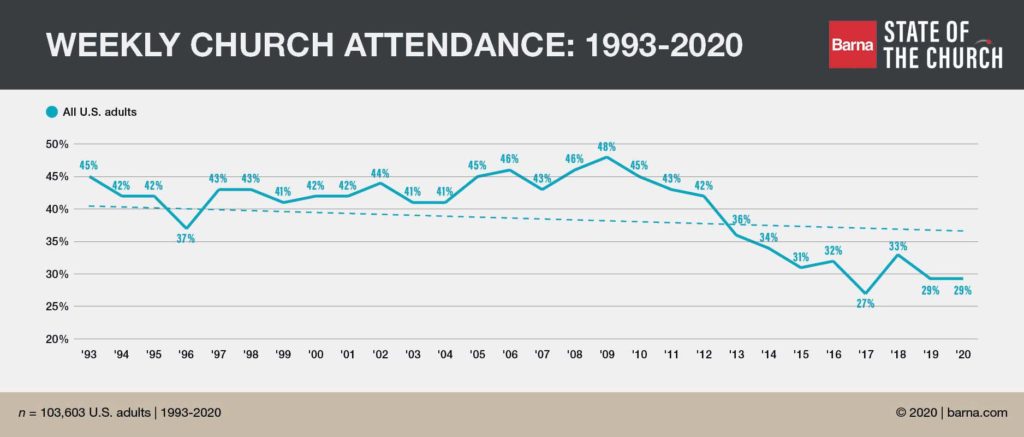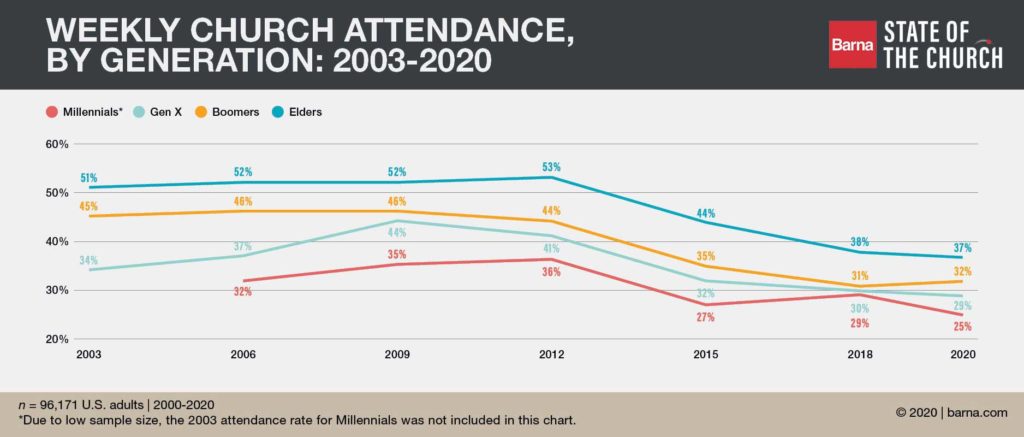Don’t Go Back to Church. Go Forward to Church
I get it. In the face of months of quarantine, separation from friends, and going to church online, you’ve had enough. It’s way outside your norm or your comfort zone and you’re tired of it.
Things are starting to open up like restaurants, bars, tattoo parlors, and salons and because of it, churches are starting to develop and execute their “back to church” plans as well.
Many leaders have worked hard to adapt to a digital-only version of church and have done a fantastic job! Really, you have. But now, there will be an inevitable pull towards going back to doing what you know, and I’m here to tell you not to do that.
I firmly believe that doing hard things with a purpose is always worth it, and I think there’s a bigger purpose here than getting back to something familiar that we feel like we’re good at. This digital experiment we’ve all been in has been challenging and rewarding but overall it has been a good push forward.
We’ve always needed a little push.
When the printing press became available to print the Bible in a language everyone could read, there were those who said it was not needed or could be dangerous.
When radio became accessible there were those who thought it a waste of money but others who built incredible ministries on it like Billy Graham.
When video broadcasting became affordable, some called it “evil” to try and create ministry on TV and there are others who did a lot of good (and some a lot of damage) for the Kingdom.
Now, the internet, mobile devices, and social media have made it possible to reach each person directly at any given moment and there are some who would balk at the idea and some who would see it as a gift.
Every time there has been a major technological advancement, the church has needed a little push to embrace it and move forward to what would eventually become a normalized part of ministry.
Let’s not do that this time.
Don’t go back to the way church was. Look at what the church could be and let’s shoot for that. Let’s look at how digital can be embraced in the church as a valid place for ministry. Let’s approach it like a missionary going into a foreign land would. She would learn the language, the culture, the issues, and get to know the people.
We can embrace digital spaces if we are willing to enlarge the vision of what God has called us to: being the church.
Don’t go back to the way it was. Go forward.
Walt Disney used to tell his Imagineers to “keep moving forward” to innovate, create, and connect with their work.
As a leader, we must look to the future. Not only are we to continue teaching the Bible and calling followers of Jesus to imitate his life, but we must constantly search for the best way to do so.
That does not mean we are searching for a replacement for what we are doing, but simply new ways.
The way it was wasn’t really working
We are all aware of how church attendance has been declining for some time now. I grew up going to church at least twice a week. Now, in 2020, we define a “practicing Christian as someone who identifies as Christian, agrees strongly that faith is very important in their lives, and has attended church within the past month (Barna). Once a month.
Here are a few more stats I found from Barna, a Christian research organization that breaks down the decline of church attendance by generation:
In 2000, 49% of the US population identified as a practicing Christian. Today in 2020, 25% do. That’s 1 in 4 people. Some became non-practicing Christians and some walked away completely.
This, of course, has also affected physical church attendance. We can see from this data that it’s not just young people either.
“…the research raises urgent questions for church leaders about the nature of the relationship Americans have to Christian practice. What redefines and what anchors the churchgoing, Bible reading, and prayer of adults? Among the interesting stories in the data is that private practices of faith—such as prayer and Scripture intake—aren’t sliding as much as church attendance.” – David Kinnaman (emphasis mine).
What this tells us is that people aren’t necessarily walking away from the Christian faith practices like Bible-reading or prayer. They are walking away from attending a church in person more than anything.
The “way it was” wasn’t working as well as some thought. It’s because a culture shift took place and has been taking place for about a decade that the church has largely ignored. COVID revealed this culture shift to us and rushed us headlong into it, whether we were ready or not.
The Shift
I believe that to assume we will ever fully go back to the way things were is naive. Before you flinch at that, think about all the other major technology jumps we’ve seen.
Outside of some destructive major event, can you imagine a time the world would just up and say “You know what? No more internet or mobile devices. Let’s go back to landlines and newspapers.” I would be willing to put a lot of money down against that bet.
In my opinion (and I think many others as well), forcing us to digital spaces may have actually increased the depth at which we can delve into relationships with our people and our community. Is it possible that these newfound deeper relationships and interactions are what are actually wearing us out? Here’s what Mark Sayers said on a recent podcast with Carey Nieuwhof:
“We’re finding ourselves in a profound moment where there’s actually a loss of control,” notes Sayers, commenting on the recent data. “In moments like this, we’ve been reduced to an aspect of leadership that I actually think is biblical, [called] spiritual authority. It’s not positional leadership, it’s not leadership through charisma; it’s actual spiritual authority. In this moment of disruption, I think one of the key invitations [we need to address] is how do we lead with spiritual authority?” – Mark Sayers
The Sea Change
A “sea change” is when a profound or notable transformation takes place. It’s permanent and the thing that is changed can never go back to the way it was. That’s what has happened (and has been happening before COVID19) in the church. We are redefining normal and looking to a new model.
Understand, I am not asking you to change with the times, I’m telling you that they have changed with our without our permission or consent. The new normal is here.
I believe that this sea change, while scary for some, offers you some incredible opportunities as a church because of the digital boom than you previously might have had.
Your reach is further with digital
Because of online programming and content such as shows, services, social media, and communication tools, your ability to reach people with the Gospel beyond your community is greatly increased.
Your Texas church may begin to have regular attendees in Florida, small groups that span state and country borders, reaching into communities to which your church previously had no access. This is huge.
Your impact is deeper with digital
Likewise, your ability to minister deeper into your own community is also more significant. People today are more likely to share deeper thoughts and feelings in a digital setting than they often are in a face-to-face setting.
This allows you as a church to see more clearly where your work is needed both in your people and in your community.
Your authority is increased with digital (image)
One of the things that gave Jesus such authority in the eyes of the people was that he was like them, with them, and seemed to genuinely like being around them. The church of the attractional model has fallen into a Pharisaical practice of superiority because of its idolatry of image.
When you mingle in digital spaces as a church and a pastor you close the gap and begin to understand the heart of servant leadership. It’s the difference between leading with authority and leading out of authority.
Your empathy is fueled with digital.
Because of your digital presence, you will see more of the real conversations happening in our world and how to navigate them. Exposure to multiple races, ideas, and age groups can deepen your empathy for those who do not see the world as you do and can seriously impact your teaching from topics to tone.
This can be a very good thing if you’ll let it. Churches who have been generally accused of being tone-deaf may learn to listen and respond to people with the heart of Jesus, rather than the talking points of a political party or narrow collective experience.
Your authenticity is revealed.
This may be what we’re afraid of most. The digital space makes a person vulnerable. Vulnerable to attacks, disagreement, and sometimes pain.
But it also opens up your heart. When you “get real” with people, you may find that they sign with relief. “Good,” they say, “he’s a real person like me. Maybe I’m not so bad after all. Maybe there’s hope for me.”
For years, pastors were told to never tell a story about yourself from the pulpit that shows you have a weakness, sin, or problems left unsolved. Always show that you’ve worked through those problems so others can be inspired.
Terrible advice.
Lead with vulnerability and authenticity and people will respect you. Lead with the false pretense that you have it all together and people will idolize you to their doom.
Two Roads Diverged in a Wood
A choice lies before us. On the one hand, you can try to get back to “normal” and see who will go with you. Chances are, your hardcore devoted attendees will be there. But of course, no matter what you do they’d probably be there.
Or, you could take this opportunity to rethink words like “ministry” and “outreach” and “community.” See what the new normal looks like and blaze a trail unique to your church that reaches people you may never have thought possible.
Either way, I believe God will use your church. I really do. But what do you think is best? What do you think God wants? He has orchestrated your church to be who it is in a time when these digital tools are available.
But if it were me, and I believed that the church is made up of people, not the buildings and programs like I say I believe, I’d hope someone would come along and tell me to put my money where my mouth is and challenge me to innovate a face-to-face + digital space strategy going forward. But that’s just me.
Sources
https://www.barna.com/research/changing-state-of-the-church/
https://www.barna.com/research/current-perceptions/
https://www.barna.com/stateofthechurch/
https://www.ted.com/talks/billy_graham_on_technology_and_faith
 Seth has been in ministry for over 20 years, recently serving as Communications Director at a thriving church in North Dallas. He is also the host of The Seminary of Hard Knocks podcast, blogs at sethmuse.com, and has his Masters of Arts in Media and Communications from Dallas Theological Seminary. Seth specializes in helping church communicators use social media and content marketing to find common ground with their audience to empower them for spiritual growth.
Seth has been in ministry for over 20 years, recently serving as Communications Director at a thriving church in North Dallas. He is also the host of The Seminary of Hard Knocks podcast, blogs at sethmuse.com, and has his Masters of Arts in Media and Communications from Dallas Theological Seminary. Seth specializes in helping church communicators use social media and content marketing to find common ground with their audience to empower them for spiritual growth.



